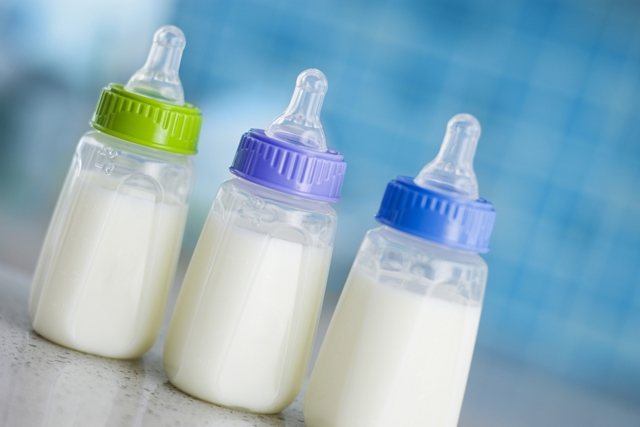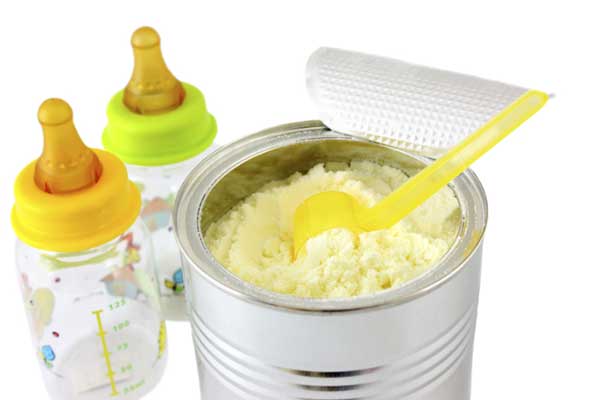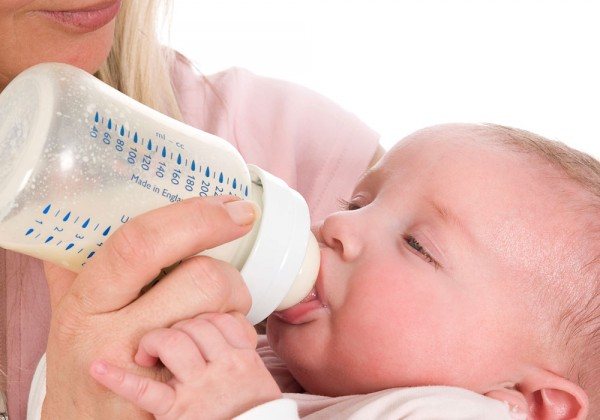Mother's milk is the best food for babies, no one can argue with that. However, for a number of reasons, breastfeeding is not always available. Artificial formulas come to the rescue: adapted, dairy and dairy-free, anti-reflux and gluten-free, iron-enriched and hypoallergenic, powder and liquid. Properly selected, they provide the baby with all the necessary substances. In addition, this is an excellent opportunity for other family members, especially the father, to participate in caring for the child. Artificial feeding has many nuances: how to choose, how to properly feed a newborn baby with formula, how many feedings there should be.
Formula feeding is an alternative if breastfeeding is not possible
How to feed formula correctly
Since a newborn baby’s stomach volume is very small, the size of its first portions is very small: at first, 30 to 60 ml of food is enough to satiate it; by the end of the second month of life, this volume reaches 900 ml per day.
For proper and complete artificial feeding of a baby, the main thing is to choose the mixture correctly: it must be chosen strictly according to the age of the baby, monitor the content of bifidobacteria, taurine and other useful substances.
To properly prepare the mixture at home, you should follow the basic rules:
- adhere to the dosage recommended by pediatricians, otherwise the child may be overfed;
- be sure to monitor the baby’s condition after feeding in order to understand in time that this type of breast milk substitute is not suitable for him or does not like him;
Important! Cooked but uneaten food cannot be left for the next feeding; the leftovers are mercilessly poured out.
- for feeding, special bottles with measuring divisions and nipples of different diameters are used, which must be thoroughly washed with hot water before each meal and sterilized more often;

Bottles are used for formula feeding
- when preparing a portion, use dry, clean utensils (measuring spoons, can openers, etc.) and strictly follow the manufacturer’s instructions;
- dry mixtures are diluted with clean boiled water (you can use bottled water - special for children), but in no case use distilled water - it is “dead” and devoid of important minerals.

Baby food is prepared in clean, dry containers
Formulas for artificial feeding

Today, the market for products for artificial feeding of children is diverse. This situation puts mothers who want to choose the right nutrition for their child in a difficult position. The entire range of mixtures can be divided into several groups:
- Adapted formulas that are fully similar in composition and properties to breast milk. They are suitable for feeding newborns from the first days of life. The composition of the mixtures is quickly absorbed by the child’s body, as they are perfectly balanced in fats, proteins, carbohydrates, microelements and other substances.
- Partially adapted, they also imitate the composition of breast milk. They can be used, like adapted ones, from birth, but more negative reactions are observed than after using the first group of mixtures.
- Unadapted, they are based on unprocessed cow's milk. Otherwise, the composition is the same as that of mixtures of the first two groups. These mixtures are not recommended for use as food for children under 6 months of age.
- Fermented milk prepared from bifidobacteria. These mixtures are recommended for babies suffering from constant constipation. They are used as additional food to the main one.
- Medicinal, combine nutritional and medicinal properties. They are prescribed for various health and development problems in babies born prematurely or with pathologies.
Read also
What to do if a child is burned - medicinal and traditional methods of burn treatment
All groups of mixtures are produced on the basis of cow's or goat's milk with the addition of vitamins and other beneficial substances. Baby food is available in the form of dry powder or ready-to-eat. The first option of dry mixtures, which are prepared very simply, is more in demand. It is important to strictly follow the instructions included with the mixture. You need to pay attention to some points:
- The temperature of the water used to dilute the mixture. It is indicated in the instructions by the manufacturer of the mixture. Usually this is the temperature of the human body and breast milk - 36–37°C.
- The ratio of components in the preparation of the mixture. It must be strictly followed, according to the instructions, as it is related to the weight and age of the baby and his nutritional needs.
- The volume of nutritional mixture per feeding should be calculated taking into account the condition and weight of the baby.
- Maintain sterility when preparing mixtures. This point must always be strictly followed when preparing baby food, but especially in the first month of a newborn’s life. At birth, the child’s intestines are sterile, and their colonization with microflora occurs gradually. It is important that pathogenic bacteria do not settle in the baby’s intestines along with the beneficial bacterial microflora. For a baby receiving formula, there is no support from the mother as breast milk protects the intestines from harmful bacteria.
For some mothers, ready-to-use milk formulas in sterile bottles are more convenient to use. When using them, you do not need to calculate the proportions and sterilize the bottles. But when using ready-made mixtures, you need to pay serious attention to production and expiration dates, storage conditions, integrity and tightness of packaging.
In conclusion, it should be noted that artificial nutrition of a child is a responsible and rather complex process. The health and development of the newborn depends on its correct implementation. It should be used only for reasonable indications and in accordance with the recommendations of the pediatrician.
How often to feed
How to properly feed a newborn with breast milk
The frequency of feedings depends on the age of the baby, as well as his condition and mood. However, on average, newly born babies eat every three to four hours a day; a short break at night is required. From 7-8 meals per year, they gradually switch to 5-4 feedings a day.
Note! You cannot force feed your baby.
If a newborn's sleep is prolonged and he may miss the next feeding, many doctors recommend gently waking him up and offering him a bottle of formula. Perhaps the baby will refresh himself without waking up.
Usually, by the end of the first month of life, the feeding regimen of bottle-fed babies stabilizes, the intervals between feedings are four hours.
Feeding a newborn with formula according to WHO
How to properly breastfeed a newborn while lying down
WHO has developed its recommendations for mothers on how to feed their babies formula, containing information about the number of feedings required for babies and the volumes of artificial formula fed, depending on age.
The volume of formula on artificial nutrition according to the child’s age
| Baby's age, months. | Volume per feeding, ml | Interval between feedings |
| Newborn up to one month | From 60 to 90 | In three to four hours |
| One | Up to 120 | In four hours |
| Two | Up to 120 | Six to seven feedings per day |
| Four | From 120 to 180 | Six feedings a day |
| Six months | From 180 to 240 | Five feedings a day |
| Year | Up to 240 | Two to three feedings, together with baby food |

To provide the child with the necessary substances, it is necessary to determine the optimal volume of the mixture
If you don’t have such a table at hand, or the parents don’t trust it, you can use the following formulas to calculate how much formula a newborn should be given per day:
- Filatova-Zaitseva or Tura (applicable for babies from the first week to 10 days of age): 2 percent of body weight at birth multiplied by the number of days of life;
- “Volume” formulas (after 10 days of life) - the volume of the mixture is determined by the current weight of the baby:
- up to 2 months – one fifth of the weight;
- from 2 to 4 months – one sixth of the weight;
- from 4 to 6 – one seventh of the mass;
- over six months - one eighth of the weight.
Additional Information. At certain periods of life, the child’s needs may deviate from the recommended norm in one direction or another; this also needs to be taken into account by mothers who practice artificial or mixed feeding. Also, the child may not be able to cope with the prescribed amount of formula in one feeding, then you should feed him in smaller portions, but more often.
Feeding regimen for a bottle-fed baby

The frequency of meals and its volumes for children growing up on formula differ from the nutrition of infants. The feeding regimen of a bottle-fed baby should be clearly planned in time. It is worth finding out in advance how many times a day to feed a newborn, what is the optimal break between meals, and how to soothe the child at night, except for formula.
How to calculate your diet
Unlike infants, artificial babies do not need to be fed on demand. On average, at 1 month a newborn should eat 8 times a day. Plus or minus one feeding. At 2 months, the number of meals can be reduced to 7.
Upon reaching 3 - 4 months, feed the baby 6 times a day. At 5 months, transfer him to 5 meals a day. He will eat this way for up to a year.
The feeding routine should be established from the birth of the baby. Then try to strictly adhere to it. Systematic violation of the schedule is fraught with overfeeding.
In this case, frequent regurgitation, excess weight gain, impaired metabolism and related problems are ensured.
If a child gets used to eating at night, none of the family members will be able to get enough sleep.
Optimal break between feedings
The pause between meals depends on the age of the baby. Due to the abundance of protein in artificial formulas, they take longer to digest than when breastfeeding.
When a newborn is fed too often, a new portion of food is added to the undigested food, complicating the work of the stomach and intestines. Don't let this happen.
Up to a month, the minimum interval is at least 2.5 hours. Then - at least 3 hours. From 5 months, the pause in feeding reaches 4-4.5 hours.
The night break in nutrition in the first weeks of life is at least 6 hours.
Eating at night
The digestive system and intestines need rest. Night is the best time for this. Up to a month, the child may not be able to withstand a night break of more than 6 hours.
From 3 months the interval should be increased to 8-10 hours. Moms know that babies sleep differently at night. For some, the regime is set up quickly and without much effort, for others, up to a year, they have to regularly stand guard at the crib, convincing the baby to sleep.
It is wrong to give your child food every time he wakes up. Hunger is not the only reason to wake up.
Perhaps the baby is experiencing discomfort from cold, stuffiness, a wet diaper or diaper, and is thirsty. Or the baby wanted to make sure that his mother was nearby and just hug and rock him enough to make him fall asleep again.
Another common cause is the sucking reflex.
Knowing for sure that the baby is not hungry, replace the bottle with a pacifier or give the baby something to drink. If the baby has not eaten his daily allowance, the feeling of hunger really interferes with sleep.
Then feed him and he will sleep soundly.
How to create a routine when transitioning from breastfeeding
If the newborn was initially fed breast milk on demand, it may be difficult to organize a regimen when switching to formula.
Be patient. If your baby clearly shows that he is hungry and it is not feeding time yet, feed him.
Increase the interval gradually. Distract your child with toys, entertainment, a pacifier, and walks. Offer him a drink. Every 10 minutes gained will help bring your routine back to normal within a few days.
At each feeding, give your baby the right amount of nutrition, then he will most likely withstand the necessary break.
Pros of eating by the hour
It is important not only to maintain a sufficient break, but also the timing of feeding. Pediatricians note that this way the baby’s body adjusts to stable functioning, and nutrition is better absorbed.
Positive aspects of nutrition by the hour:
• Benefits for digestion. The body quickly gets used to receiving food at the same time and copes well with its processing.
• Comfort for the child. The sequential mode gives him a feeling of stability and correctness of what is happening.
• Convenience for parents. By feeding your baby at a certain time, you won’t have to calculate each time how much time has passed since the last feeding. Plus, it makes it easier to plan your day.
• Children who are accustomed to a certain regime adapt better to kindergarten. And in the future, the little person will have to live according to the regime.
The routine may sometimes change depending on the circumstances and wishes of the child. If he woke up an hour earlier, it means he will want to eat without waiting for the usual time.
Make concessions, do not turn into a despot. Deviations of half an hour are quite acceptable.
Individual characteristics
Don't be surprised if your baby eats different amounts of formula at different feedings. Adults also prefer a light breakfast and a heartier lunch.
Likewise, a child may eat less in the morning and ask for more next time. The amount of food children need is also somewhat different.
For some, 100 ml at a time is enough, for others – at least 200.
Useful tips for mothers: NUTRITION UP TO 3 YEARS OLD
All standards are averaged, and it is worth taking into account the individual characteristics of your child. This will also help establish a correct and stable feeding regimen.
Can't set up a routine? Do not give up!
It is not always easy for a child to agree to live according to the regime. Be patient and don't give up. Ultimately, everyone benefits from a good routine. Does your baby insistently demand a bottle every hour?
Turn on your imagination, keep him busy, give him something to drink. If you follow the lead once, you won’t see the long-awaited regime. By gradually bringing the routine back to normal, you will stabilize the life of the whole family.
The child will get used to eating over time, the functioning of his body will improve, and there will be fewer night rises.
The emotional side of the regime
It is important not only to feed the baby on time and to the full, but also to create an atmosphere of love and care.
Babies, having drunk their mother's milk, may not let go of the breast in order to satisfy their sucking reflex. Artificial children sometimes lack one bottle.
You can offer your toddler a pacifier. Children with a highly developed sucking reflex replace it with their own fingers. Agree, it would be better to be a dummy.
Feeding should take place in a calm, warm atmosphere. The baby should feel that he is close to people who love him.
After feeding your baby, do not rush to put him in the crib. Pet him and rock him so that he feels calm and safe.
How to understand that the regime is suitable for a child
Once the feeding schedule is established, you can easily determine whether your baby likes it. The following signs will indicate this:
- the child waits for the next feeding without whims;
- sleeps well;
- eats with appetite;
- urinates at least 12 times a day;
- has stool at least once a day;
- is in a good mood.
Read also
Social adaptation in kindergarten: how to help your child reduce stress and get used to a new team
If your baby is not gaining weight well, despite regular and nutritious meals, sleeps restlessly and is constantly naughty, consult your doctor.
Dr. Komarovsky about diet
The pediatrician is confident that a healthy child can be raised both with regular feeding and with free feeding. Mom herself must decide which method is more convenient for her.
It’s easier to endure the whims for a while, but develop a normal regime, than to suffer for many more months. If the mother is happy, the husband and child will be happy.
The normal interval between meals for a newborn is from 2 to 3.5 hours. If the baby is gaining weight normally, the interval can be increased.
There is no need to wake up the baby to feed. Only if these are premature babies or children who are underweight.
A child who has eaten well may not want to eat before 2 hours later. But wanting attention or satisfying the sucking reflex is fine.
Setting up a routine is not always easy. But after surviving for several days, you will gain stability in the daily routine and functioning of the child’s body.
It is important to strictly observe the minimum intervals between feedings, not to encourage night awakenings, and not to give food as soon as the baby cries.
Besides hunger, there are many other reasons for whims.
Make sure your child is comfortable and not thirsty, cold or hot. By establishing an hourly routine, you will appreciate numerous benefits.
Whether the regime is suitable for the baby can be determined by several signs. Attract your baby more, play, walk, give him your warmth.
Approximate feeding regimen for 1-3 months
Until what age should a child be fed formula?
If a mother is thinking about how to properly feed her newborn with formula, first of all, she must adhere to her child’s diet. In the first 30 days of life, an infant mainly sleeps and eats, so feedings alternate with 2.5-3 hour breaks throughout the day, and the baby must also be accustomed to a night break (after a month, a 6-hour rest for the small ventricle is recommended).

It is recommended to take a short break from feeding at night.
Starting at 2 months of age, the baby has 18 hours for 6 meals, approximately every 3 hours. It is not necessary to follow a precise schedule down to the minute; you should not allow the baby to cry from hunger for too long while waiting for the next feeding, but you should stretch out the time until this moment as much as possible. Gradually the little person adapts to the regime.
When creating a formula feeding schedule, you should not focus on the frequency of breastfeeding of breastfed babies - infant formula and human milk have different rates of absorption by the baby's digestive tract. An artificial product is more filling, so babies are breastfeeding much more often than bottle feeding.
Also, drinking diluted formula from a hole in the nipple is much faster than sucking milk from the breast: the bottle will end in 10 minutes, and you can “hang” on the breast for hours.
Additional Information. When artificially feeding babies, it is advisable to supplement their diet with clean water; its volume is not counted as nutrition.
Mixed feeding: how to organize it correctly
For a child of the first year of life, and even more so for a newborn, there is nothing better than breastfeeding (BF). But for various reasons, it also happens that exclusive breastfeeding is not possible, and formula comes to the aid of mother and baby. Mixed feeding of a baby - experts and Littlewana mothers tell you how to feed correctly.
Read also
Buckwheat porridge for a child: the value of the composition of the cereal, the pros and cons of eating it, simple cooking methods

Artificial feeding is a complete replacement of breastfeeding with artificial formulas. Mixed feeding is a partial replacement, when the share of the substitute in the diet is at least 1/5.
Mixed feeding of newborns: how to feed correctly (graph)
If a mother truly cannot produce enough milk (a very low percentage of all women), it is almost always possible to establish a mixed diet.
Feeding schedule and volume
It is customary to feed bottle-fed babies according to a schedule: up to 1 month - on demand, but no more than 10 times a day; 1–3 months - about 7 times; 3–4 months - about 6 times; from 4 months to a year - about 5 times a day.
If you have a mixed diet, replace breastfeeding with formula in this scheme only when you really don’t have enough milk. For example, up to three months it is recommended to feed every three hours; replace breastfeeding only when the breast is empty at the right time.
Some pediatricians take a different point of view. They advise from birth to choose the minimum time between feedings - 2.5 hours. What are their recommendations based on? When food enters the child’s stomach, it undergoes fermentation, after which the entire volume from the stomach moves further into the intestines, where the digestion stage is completed (with the help of bacteria). Now imagine: the first portion of food is almost digested, the stomach is ready to send it further, and then a new portion arrives. What will the stomach do? It will correctly send “further” everything that is in it, both digested and fresh. After which the “sour” milk, ready for absorption, will be digested, and the “fresh” milk will begin to ferment in the intestines with the formation of a large amount of gases (hello, colic).
Required daily volume of formula for artificial feeding (one of the generally accepted options):
- up to 2 months - 1/5 of body weight - 700–750 ml (100 ml per feeding);
- 2-4 months - 1/6 body weight - 750–800 ml (140 ml per feeding);
- 4–6 months – 1/7 body weight – 800–900 ml (170 ml per feeding);
- more than 6 months - 1/8-1/9 body weight - 1000-1100 ml (200 ml per feeding).
How to maintain breastfeeding with a mixed diet:
Feed your baby in your arms face to face.
Despite mixed feeding, always hold your baby in your arms while feeding. Avoid supplementary feeding to an infant lying in a crib or stroller. Do not deprive your baby of contact and communication with you, your warmth, the feeling of your skin, the sound of your heart and voice, no matter what. The importance of your closeness, affection and love cannot be overstated for your emotional, neurological and social health.
Don’t believe that bottle feeding is better than mixed feeding, even a little breast milk is good!
There is a deliberately erroneous opinion that completely artificial feeding is better than mixed feeding. Allegedly due to the fact that the child’s digestive system is “confused” and suffers from this. In fact, even a small amount of breast milk in the diet is an invaluable contribution to health!
Donor milk is the supplement of choice.
Important: according to WHO data, “highest grade” supplementary feeding is expressed milk from the mother. Next, the choice should be donor milk - i.e. another woman's breast milk. It is human milk, and not formula, that is the supplement of choice for infants. Now banks of donor milk have begun to appear in Russia (in Europe and the USA this has been a common practice for decades). And you can always contact the volunteer service that coordinates the free exchange.
Don't cook at home.
No matter how committed you are to a healthy lifestyle, organic nutrition and “homemade” products, when feeding a newborn (and children under 2 years old) between animal milk and an adapted formula, make a choice in favor of the formula.
Hydrolyzed formulas for sensitive babies.
Conventional mixtures contain protein molecules that are too large and difficult to digest. If you notice that supplemental feeding is not suitable for your child, discuss feeding a hydrolyzed formula with your pediatrician. In hydrolysates, the protein is split into smaller parts that are tolerable for the baby's body. The taste of this supplement is different from the usual ones; be prepared for the fact that the child will need some time to get used to it.
Choose your ingredients carefully.
Pay attention to the content of polyunsaturated fatty acids (DHA and ARA), DNA and RNA nucleotides, acidophilus and bifidum bacteria.
However, there are two “buts”: at the moment it has not been possible to adapt the formulas in terms of the quantity and quality of protein (breast milk contains 0.8-1.2 g/l, and in formulas at least 2 g/l). An excess of proteins is an increased burden on the digestive tract, kidneys and immune system. And the proteins of foreign milk themselves are intended for other purposes (why, for example, should a calf be smart, it needs to be strong = have more muscle mass, because among the proteins of cow's milk there is more casein, not A-globulin, and there are no proteins responsible for local immunity at all) . And the second “but” is breast milk fats, which are replaced by vegetable fats (mainly palm fats) for the simple reason that they are “unique” and it is not possible to synthesize them artificially. Otherwise, modern mixtures differ little from each other.
Supplementary feeding not from a bottle.
Highly recommended if you want to transition to exclusive breastfeeding. Mixed feeding will also last longer with this method of supplementary feeding, because the risk of the baby refusing to breastfeed will be minimal. The nipple on the bottle and the pacifier (no matter how “friendly” breastfeeding they are positioned by the manufacturer and no matter what shape they are) often provoke the child’s reluctance to suckle at the breast, soreness in the mother’s nipples, crying during feeding and reduce the time the child spends at the breast. This occurs for purely mechanical reasons due to the confusion of sucking methods and a constant flow from the bottle, instead of varying strength from the chest. And for psychological reasons - the baby eventually agrees to suck the persistently offered substitutes and begins to treat his mother’s breast with resentment and negativity. If you have absolutely no choice but to leave your baby with someone who is adamant about bottle-feeding, make sure you get the one that you think is most appropriate and talk about the importance of hand-feeding your baby.
Reduce your health risks from BPA.
Do not pour hot water into polycarbonate bottles to mix the powder mixture into the water. Instead, use a glass, ceramic or stainless steel container to prepare the formula and then quickly cool to the desired temperature and pour directly into the feeding bottle. Do not use microwave ovens to heat the mixture. Detailed information about the dangers of BPA can be found on the websites of IBFAN, WHO, EFSA.
Sleep in the same room, at arm's length, or with your baby.
Regardless of the type of feeding, provide the baby with natural, comfortable and safe sleep. Co-sleeping reduces sudden infant death syndrome and allows the mother to be sensitive to the slightest manifestation of discomfort in the baby, and in the case of mixed feeding, to feed more often at night.
Carry in your arms or in a sling.
Artificially and mixed-fed children expect the same things from the first months of life as children on breastfeeding! Namely, a kind of “gestation” in the arms of loving parents.
Continue feeding until at least 18 months.
When bottle-fed from birth, the formula usually remains in the diet for up to one and a half to two years and longer at the discretion of the parents. If for some reason you interrupt breastfeeding before or about a year: to avoid or reduce the severity of digestive problems, introduce breast milk substitutes for at least one and a half years, do not immediately transfer the baby completely to the common table.
You can always return the GW.
Remember that the return of lactation is often possible, and your strong desire and support of loved ones alone significantly increases the chances of success.
Can I feed formula on demand?
Almost all pediatricians and mothers who practice breastfeeding believe that the baby should be fed at the first squeak. Some parents who, for one reason or another, bottle-feed their children in order to quell some feelings of guilt, also wonder whether it is possible to feed formula on demand to a newborn baby.
Pediatricians answer unequivocally - no. The difference between breast milk and even the best and most expensive super-adapted formula is that the former is absorbed faster; it produces exactly as much as the baby sucked in the previous feeding. This does not happen with formula - it is prepared by the mother or another parent in strictly measured quantities.
In addition, if you offer your baby food at a certain time, this will quickly help him adapt to the given rhythm of life, food will organically fit into the daily routine, and parents (especially mother) will be able to plan other things. This can be called one of the positive aspects of artificial feeding of newborns.
Why you can't feed formula on demand
The child’s body takes much longer to digest artificial milk food, so breaks in nutrition are simply necessary so that the already half-digested food in the baby’s stomach does not mix with the newly arriving food.
If your baby smacks his lips after bottle feeding, this does not clearly mean that he is not full. All infants have a very developed sucking reflex, so you can offer the baby a pacifier, but not an additional portion of nutritional formula. Perhaps the child is simply thirsty (water must be in the diet of artificial children).
Consequences of uncontrolled consumption of the mixture
If mothers decide to listen to the supposedly “natural urges of the baby’s body” and bottle-feed him, as they do with breast milk, at the first squeak, quite serious consequences can occur for the health of such newborns. There is an increased risk of overfeeding and over-saturating the child’s fragile body with nutrients and protein. In the future, this threatens the appearance of obesity of various degrees, indigestion, disruption of the digestive organs, dysbacteriosis, and problems with falling asleep.

Uncontrolled eating of formula can cause obesity in a newborn
The child begins to show signs of allergies, after which the formula has to be selected again and again, and the mother’s feeling of guilt worsens for the fact that she cannot breastfeed her child.
Infant formulas are an excellent substitute for breast milk, but they impose a number of conditions on feeders on how to properly feed a newborn with formula so that the child receives with food all the substances necessary for growth and development. What volume of formula and how often to give to the baby is determined according to the WHO table, various formulas and recommendations of pediatricians, depending on the weight and age of the child.
Mixed feeding: how to supplement your baby with formula while breastfeeding
There are situations when a baby needs to be supplemented, for example, when the mother needs to leave home or the baby has big appetites and does not have enough mother’s milk.
If supplementary feeding with formula makes up less than half of the baby’s total diet, this is called mixed feeding.
To determine the amount of supplementary feeding needed, you need to know how much breast milk the baby eats.
To do this, weigh the baby on special baby scales before and after meals, but do not change the diaper or change the baby’s clothes so that the measurements are as accurate as possible.
- By doing such weighings throughout the day, you will determine how much your child eats per day.
- Now calculate, depending on the weight and age of the child, how much he should eat
- Supplement the difference with the mixture, dividing it into several feedings or one, depending on the circumstances.
- For example, in the evening the mother usually produces less milk than in the first half of the day, so it would be reasonable to supplement the baby with baby food before going to bed at night.

Also use another method and determine when to supplement the child’s feeding based on his behavior; if after feeding he shows anxiety and dissatisfaction, most likely he is not full and needs to be supplemented.
Please note that the formula should be given to the baby only after breastfeeding, if we are talking about a lack of milk in the mother. In this case, over time, you need to gradually reduce the volume of the formula in favor of breast milk.
ADVICE : It is advisable to feed a mixed-fed baby with a teaspoon or a syringe without a needle. Try not to use a bottle, because... The baby may decide that it is easier to suck from a bottle and milk is constantly coming in, and this can lead to breast refusal. After feeding, be sure to hold the baby upright so that all trapped air comes out.











